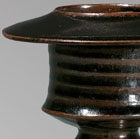J.J. Lally & Co., Oriental Art / New York City, New York
MenuPast Exhibition
SONG DYNASTY CERAMICS:
The Ronald W. Longsdorf Collection
March 15 - April 13, 2013
54.
A CIZHOU BROWN-GLAZED INCENSE BURNER
Northern Song Dynasty (A.D. 960-1127)
with wide flaring and gently down-curved rim surmounting a cylindrical vessel raised on a high pedestal foot of inverted trumpet shape with an accordion-fold flange on the stem, covered with a very dark brown-black glaze thinning to rust-brown at the margins and over the horizontal wheel-marks encircling the sides of the cylinder, the interior of the censer and the deeply recessed inside of the foot unglazed and the exposed stoneware fired grayish-buff.
Height 4 1⁄4 inches (10.8 cm)
A similar example of larger size, in the Asian Art Museum of San Francisco, from the Avery Brundage Collection, is illustrated by He, Chinese Ceramics: The New Standard Guide, London, 1996, p. 165, no. 303, and the same vessel is illustrated by Mowry, Hare’s Fur, Tortoiseshell, and Partridge Feathers: Chinese Brown- and Black-Glazed Ceramics, 400-1400, Cambridge, 1996, pp. 131-132, no. 30 where the author notes that metal censers of this form, presumably the prototype for the pottery examples, are first seen in Buddhist paintings and sculpture in the Tang period.
Compare also the similar black-glazed stoneware incense burner excavated at an 11th century tomb at Taiyuan, Shanxi province and now in the Shanxi Museum, illustrated by Zhang (ed.) in Zhongguo chutu ciqi quanji (5) Shanxi (Complete Collection of Ceramic Art Unearthed in China, Vol. 5, Shanxi Province), Beijing, 2008 p. 68, no. 68; and another similar black-glazed censer discovered at the Dengfeng kiln site in Zhengzhou, Henan province, illustrated by Li and Liu (eds.) in Zhongguo Dengfeng yao (Chinese Dengfeng Ceramics), Beijing, 2011, p. 71.
北宋 磁州黑釉香薰 高 10.8 厘米
